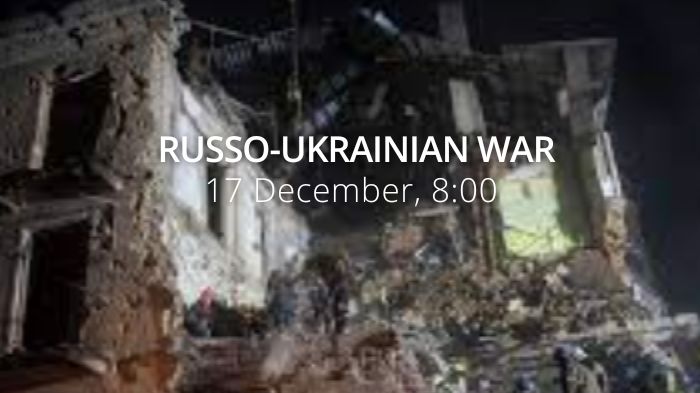Russia launched another massive missile attack targeting Ukrainian civilian facilities and power grids. 60 out of 76 missiles downed by Ukrainian Air Defense. Power outages reported around the country.
Daily overview — Summary report, December 17
https://twitter.com/EuromaidanPress/status/1603692570126831619
The General Staff’s operational update regarding the Russian invasion as of 06.00 am, December 17, 2022 is in the dropdown menu below:
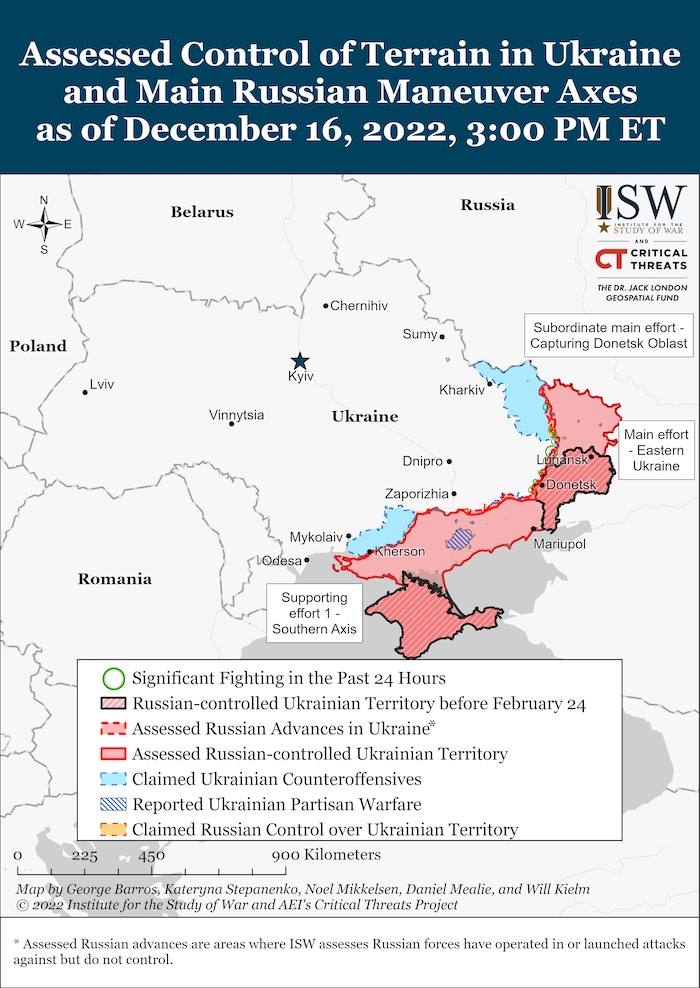
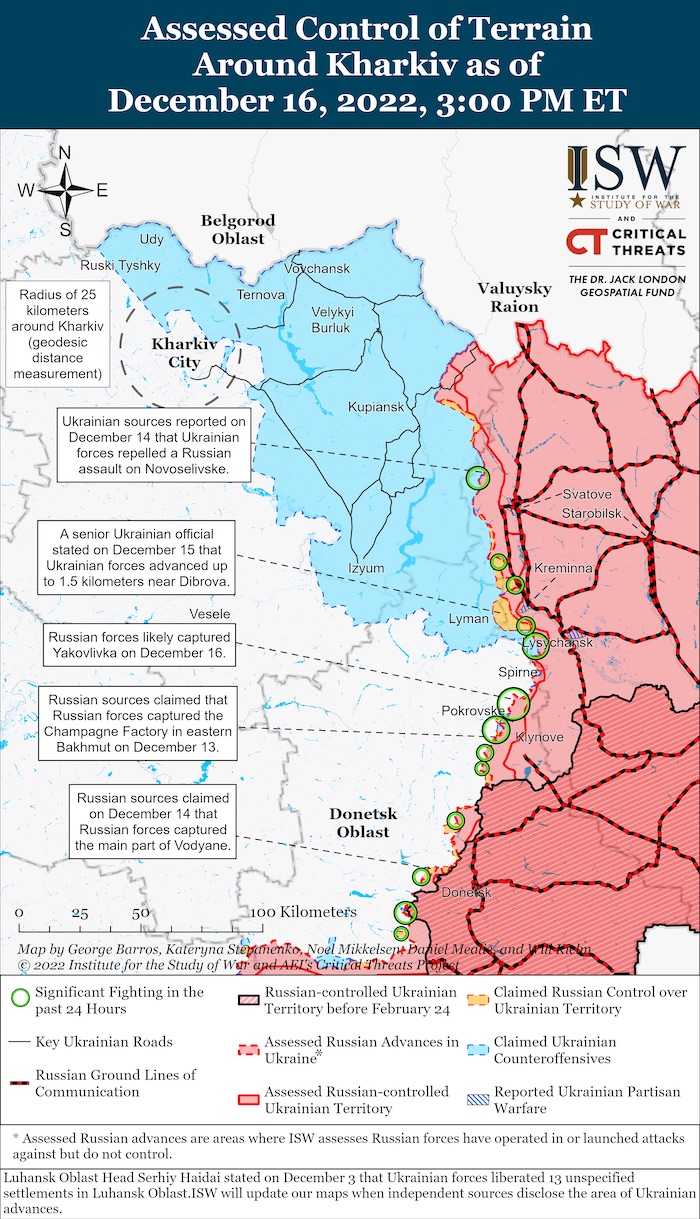
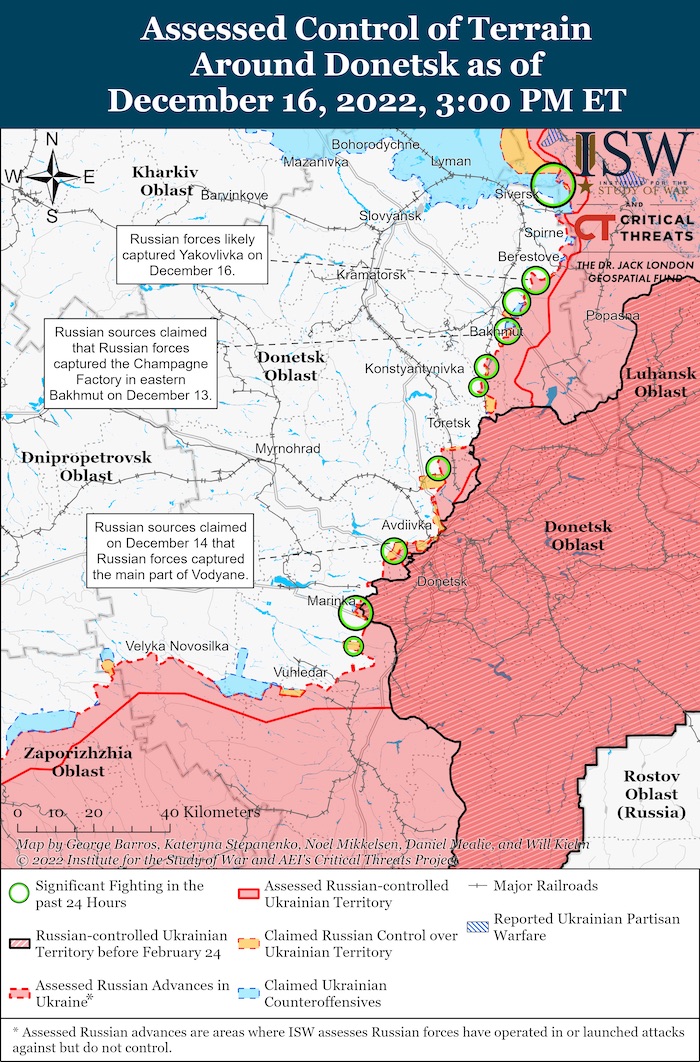
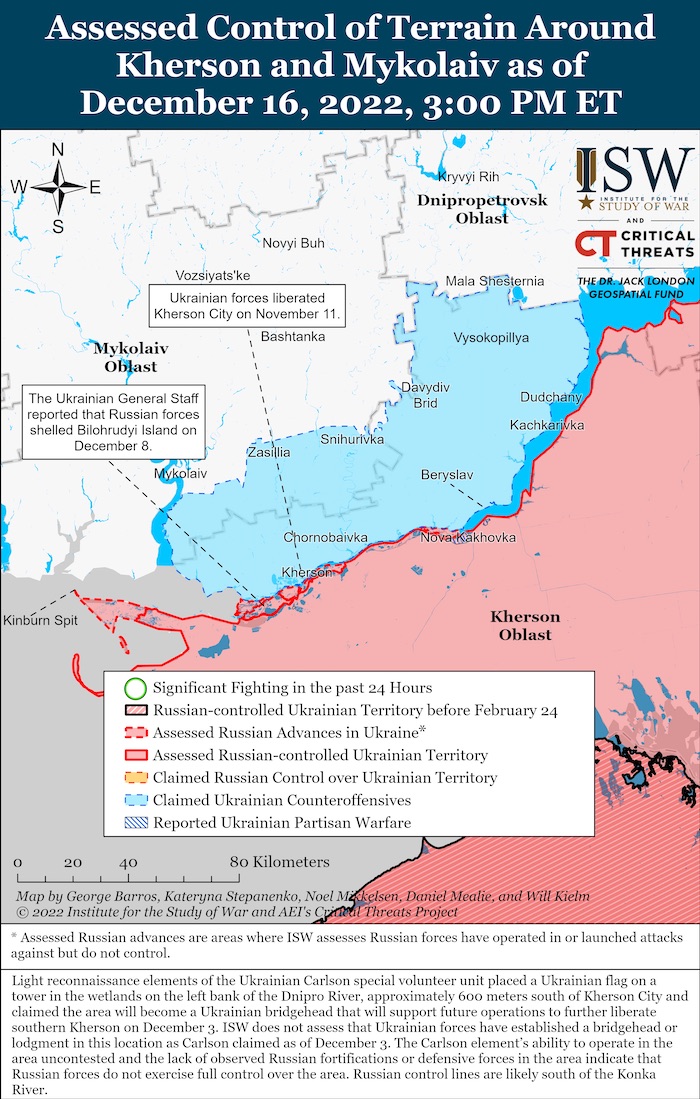
Military Updates
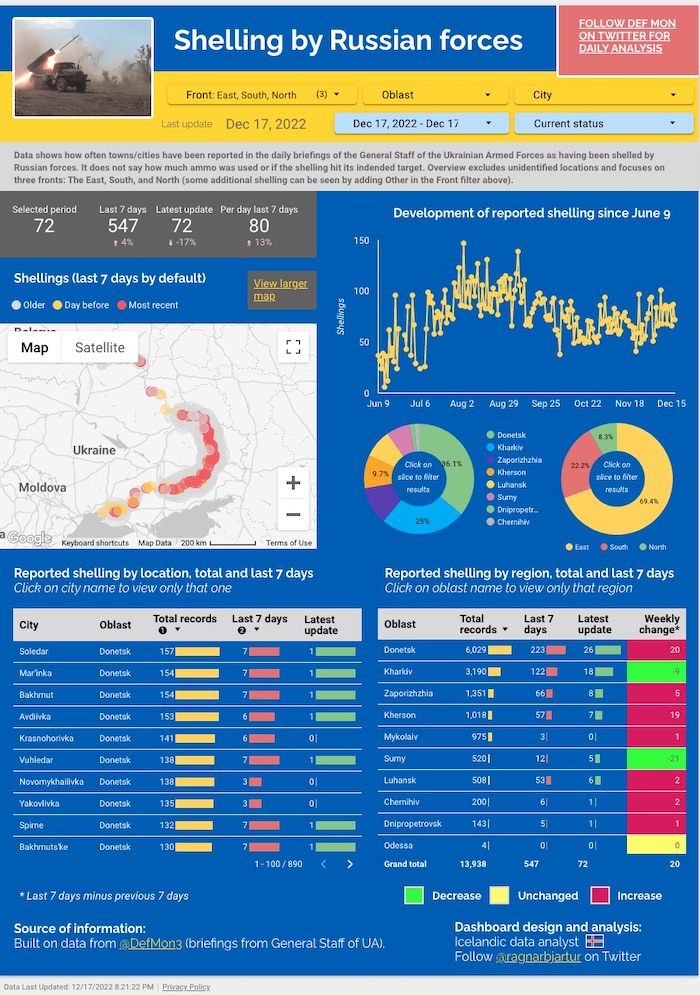
Russia launched a massive missile attack in Ukraine targeting civilian facilities and power grids, using 76 missiles including 72 cruise missiles(Kh-101, Kalibr, Kh-22), 4 ASM (Kh-59,Kh-31P). 60 shot down by the Ukrainian air defense. Additionally, Russia launched some 27 land-based S-300 air defense missiles targeting frontline cities. The Russian attack killed at least two, wounded at least 10 civilians in two regions, and damaged at least nine power-generating facilities causing power cuts in several regions.
Seven cities targeted, including Kharkiv and Sumy, Poltava, Dnipro and Kyiv. Power outages reported.
Russia is readying for renewed invasion in February – Def Min Reznikov. Suspilne reports that Ukraine, with the help of allies, has increased the effectiveness of its air defenses by up to 80% as of December against Russian missile attacks on critical infrastructure, including the energy grid. However, Ukraine’s Defense Minister, Oleksii Reznikov, told the Guardian that evidence was emerging that the Kremlin was planning a new large-scale offensive in February 2023.
Russians in occupied Crimea are preparing to prevent landing of Ukrainian troops – Defense Intelligence. The Defence Intelligence of the Ministry of Defence of Ukraine (HUR) reports that Russians in occupied Crimea are mining the coastline to prevent the landing of Ukrainian troops.
According to British Defence Intelligence, (last 48 hours):
- In recent days, there has been an uptick in Russia’s campaign of long-range strikes against Ukraine’s critical national infrastructure.
- The waves of strikes have largely consisted of air and maritime launched cruise missiles, but have almost certainly also included Iranian-provided uncrewed aerial vehicles (UAVs) being launched from Russia’s Krasnodar region.
- Previously these UAVs had been primarily launched from locations within occupied Crimea. The change of launch site is likely due to Russian concerns about the vulnerability of Crimea, while it is also convenient for resupply from the weapons’ likely arrival point in Russia, at Astrakhan.
Losses of the Russian army
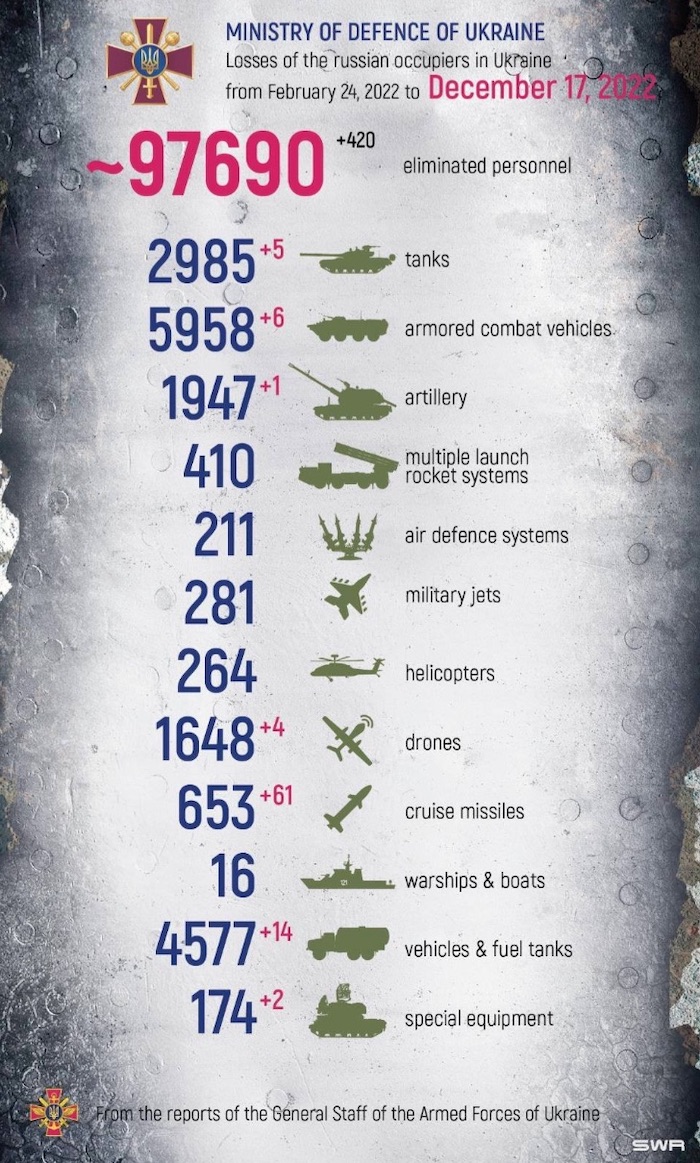
Humanitarian
In Kryvyy Rih, a residential building was hit. 4 killed, including a one-year-old boy.
On December 15 only, Russian troops killed 14 and injured 30 civilians in Ukraine.
Environmental
Russia destroys Europe’s largest poultry farm, 4.4mn chickens dead. Ekonomichna Pravda reports that the occupiers looted and destroyed the factory, according to Oleg Bakhmatyuk’s Avangard Agricultural Holding, which owns the largest poultry farm in Ukraine and Europe, “Chornobaivska” company (Kherson Oblast).
Legal
Australian state hacker preparing “digital tribunal” for Putin’s cyberarmy. Speaking with Ekonomichna Pravda, Australian state hacker and CEO of the Internet 2.0 cybersecurity company Robert Potter said that its possible to punish Russian hackers attacking Ukraine on the the Kremlin’s orders.
Support
White House says next security aid package for Ukraine with more air defense means coming – Reuters. The next security assistance package for Ukraine is coming with more air defense capabilities for the country, says John Kirby, spokesperson for the White House National Security Council, according to Reuters.
EU adopts 9th package of economic & individual sanctions against Russia: about 200 entities sanctioned. On 16 December, the Council of the European Union adopted the ninth package of sanctions against the Russian Federation in response to Russia’s continuing war of aggression against Ukraine and “the gravity of the current escalation against civilians and civilian infrastructure,” according to the press release published on the EU Council’s website.
Hungary freezes Russian assets worth €870 million. European Pravda reports, citing the Hungarian newspaper Népszava, that Hungary has frozen approximately Ft350 billion (€870 million) worth of Russian assets, as of 25 November. According to a recent evaluation by the European Commission.
US Ambassador to Ukraine Bridget A. Brink thanked Ukrainian air defense for protecting the country from Russian missile strikes. “First US shipment of emergency repair equipment has already arrived – Ukraine will prevail,” she added.
https://twitter.com/EuromaidanPress/status/1603798589410623494
New Developments
In the latest incident of decolonization and de-Russification in Ukraine, monument to Russian poet Pushkin taken down in central-Ukrainian Dnipro
"Pushkinfall" continues "Leninfall," the decommunization process launched in Ukraine after Euromaidan in 2014 https://t.co/wkiRiqczs2 pic.twitter.com/MO6buIqx9I
— Euromaidan Press (@EuromaidanPress) December 16, 2022
Monument to Russian poet Pushkin taken down in central-Ukrainian Dnipro. In the latest incident of decolonization and de-Russification in Ukraine, the central-Ukrainan city of Dnipro has dismantled a bust to Russian poet Aleksandr Pushkin and Soviet pioneer Volodia Dubinin, Hromadske reported.
Western companies supplied components for Russian Orlan drones despite sanctions – media. Western manufacturers continue to supply components for the Orlan-10 drone to Russia through intermediary firms. In 2022, companies supplied $25.5 mn worth of components to the Russian authorities, according to a joint investigation by iStories, Reuters, and the Royal United Services Institute (RUSI) published on December 15.
On Dec 16, Croatian MPs rejected a proposal for Croatia to join an EU mission in support of the Ukrainian military. The government needed 101 votes in the 151-seat parliament – a two-thirds majority – to pass the proposal, which was narrowly rejected 97-10.
On Dec 16, Croatian MPs rejected a proposal for Croatia to join an EU mission in support of the Ukrainian military
The govt needed 101 votes in the 151-seat parliament – a two-thirds majority – to pass the proposal, which was narrowly rejected 97-10.https://t.co/fOl63lm8g0
— Euromaidan Press (@EuromaidanPress) December 16, 2022
Assessment
- On the war.
The Institute for the Study of War has made the following assessment as of December 16, 2022:
Russian forces conducted their ninth large-scale missile campaign against critical Ukrainian energy infrastructure on December 16 and carried out one of the largest missile attacks on Kyiv to date. Ukrainian Commander-in-Chief General Valery Zaluzhny stated that Ukrainian air defenses shot down 60 of 76 Russian missiles, of which 72 were cruise missiles of the Kh-101, Kalibr, and Kh-22 types, and four guided missiles of the Kh-59 and Kh-31P types.[1] The Kyiv City Military Administration reported that Ukrainian forces destroyed 37 of 40 missiles targeting Kyiv.[2] Ukrainian officials also reported that Russian missiles struck nine energy infrastructure facilities and some residential buildings in Zhytomyr, Kyiv, Kharkiv, Dnipropetrovsk, and Zaporizhzhia oblasts.[3] Ukrainian military officials noted that Russian forces launched most of their missiles from the Black and Caspian seas and the Engels airfield in Saratov Oblast.[4] Russian forces are likely intensifying their strikes on Kyiv to stir up societal discontent in the capital, but these missile attacks are unlikely to break Ukrainian will.
Russian strikes continue to pose a significant threat to Ukrainian civilians but are not improving the ability of Russian forces to conduct offensive operations in Ukraine. Ukraine’s state electricity transmission system operator Ukrenergo stated that restoration of electricity may be delayed by the December 16 strikes and announced a state of emergency aimed at electricity market suppliers.[5] Ukrenergo added that Ukraine’s United Energy System had to cut more than 50% of energy consumption as a result of the strikes.[6]
Russian National Security Council Deputy Chairman Dmitry Medvedev made inflammatory but irrelevant comments in support of ongoing information operations that aim to weaken Western support for Ukraine. Medvedev published on December 16 a list of what he described as legitimate military targets, which included “the armed forces of other countries that have officially entered the war” in Ukraine.[7] Medvedev rhetorically questioned whether Western military aid to Ukraine means that NATO members have entered the war against Russia.[8] Medvedev did not explicitly state that the armed forces of NATO members are legitimate military targets nor that he was stating an official Russian position on legitimate targets in the war in Ukraine.[9] Medvedev likely made the comments in coordination with the large-scale Russian missile strikes in an attempt to weaken Western support for Ukraine by stoking fears of escalation between the West and Russia. Medvedev has previously made purposefully inflammatory comments in support of other information operations with the same aims.[10] Medvedev’s past and current inflammatory rhetoric continues to be out of touch with actual Kremlin positions regarding the war in Ukraine. Russian forces have and will likely continue to target Western military equipment that Ukrainian forces have deployed in Ukraine, of course, but there is nothing surprising or remarkable in that fact.
Russian President Vladimir Putin will likely pressure Belarusian President Alexander Lukashenko for Russian-Belarusian integration concessions at an upcoming December 19 meeting in Minsk—Putin’s first meeting with Lukashenko in Minsk since 2019.[11]Lukashenko and Putin reportedly will discuss Russian-Belarusian integration issues, unspecified military-political issues, and implementing Union State programs.[12] The Union State is a supranational agreement from 1997 with the stated goal of the federal integration of Russia and Belarus under a joint structure. The Kremlin seeks to use the Union State to establish Russian suzerainty (control) over Belarus.[13]
Lukashenko is already setting information conditions to deflect Russian integration demands as he has done for decades.[14]Lukashenko stressed that “nobody but us is ruling Belarus,” and that Belarus is ready to build relations with Russia but that their ties “should always proceed from the premise that we are a sovereign and independent state.”[15] It is unclear whether Putin will be successful in extracting his desired concessions from Lukashenko. Lukashenko has so far largely resisted intensified Russian integration demands and has refused to commit Belarusian forces to join Russia’s invasion of Ukraine.
Putin’s visit to Minsk could indicate that Putin is trying to set conditions for the newly assessed most dangerous course of action (MDCOA) that ISW reported on December 15: a renewed offensive against Ukraine—possibly against northern Ukraine or Kyiv—in winter 2023.[16] Russian Defense Minister Sergei Shoigu and Belarusian Defense Minister Viktor Khrenin signed an unspecified document to further strengthen bilateral security ties—likely in the context of the Russian-Belarusian Union State—and increase Russian pressure on Belarus to further support the Russian invasion of Ukraine, in Minsk on December 3.[17] ISW’s December 15 MDCOA warning forecast about a potential Russian offensive against northern Ukraine in winter 2023 remains a worst-case scenario within the forecast cone. ISW currently assesses a Russian invasion of Ukraine from Belarus as low, but possible. Belarusian forces remain extremely unlikely to invade Ukraine without a Russian strike force. It is far from clear that Lukashenko would commit Belarusian forces to fight in Ukraine even alongside Russian troops. There are still no indicators that Russian forces are forming a strike force in Belarus.[18]
Putin and Lukashenko’s meeting will—at a minimum—advance a separate Russian information operation that seeks to break Ukrainian will and Western willingness to support Ukraine, however. This meeting will reinforce the Russian information operation designed to convince Ukrainians and Westerners that Russia may attack Ukraine from Belarus. Russia’s continued strikes against Kyiv, constant troop deployments to Belarus, and continued bellicose rhetoric are part of (and mutually reinforce) this information operation. The Kremlin is unlikely to break the Ukrainian will to fight. The Kremlin likely seeks to convince the West to accept a false fait accompli that Ukraine cannot materially alter the current front lines and that the war is effectively stalemated. ISW assesses that such a conclusion is inaccurate and that Ukraine stands a good chance of regaining considerable critical terrain in the coming months.
Russian President Vladimir Putin reportedly ignored warnings about worst-case economic scenario assessments from senior Kremlin financial advisors prior to launching his full-scale invasion of Ukraine in February 2022. Unnamed sources told theFinancial Times (FT) that the head of the Russian Central Bank, Elvira Nabiullina, and the head of Sberbank, German Gref, briefed a 39-page assessment to Putin outlining the long-term damage to the Russian economy if Russia recognized the independence of proxy republics in Donetsk and Luhansk oblasts a month prior to the full-scale invasion.[19] FT sources noted that both Nabiullina and Gref spoke to Putin of their own initiative but were not brave enough to tell Putin that Russia risked a geopolitical disaster when he interrupted the brief to ask how Russia can prevent a worst-case scenario. Nabiullina and Gref specifically warned Putin that Western sanctions would set the Russian economy back by decades and negatively impact the Russian quality of life. Both Nabiullina and Gref reportedly were shocked when Putin launched the invasion on February 24 and indirectly expressed some discontent to their inner circles, despite implementing provisions to mitigate some negative impacts of sanctions during the first weeks of the war.
The report, if true, indicates that Putin had received some prognosis of the war’s risks and costs but decided to ignore them in favor of his maximalist goal of seizing Ukraine. It is unclear if Putin received and subsequently ignored similar reports from the Russian Ministry of Defense (MoD) or the Ministry of Foreign Affairs (MFA), but his engagement with Nabiullina and Gref shows that he had some awareness of the potential long-term risks of the war. Nabiullina’s and Gref’s reported hesitance to dissuade Putin also demonstrates the unbalanced power dynamic that may have prompted some Russian officials to play along with Putin’s bad decisions rather than remonstrating with him.
Russia is continuing to endure some economic challenges as a direct result of Putin’s war in Ukraine. FT reported that Nabiullina was able to protect the Russian economy from the worst-case scenario by undertaking provisions such as regulation of the exchange control during the first day of the war, but some war costs are likely catching up to the Kremlin. Russia’s Central Bank announced on December 16 that mobilization had sparked increasing manpower shortages across several industries in Russia.[20] The Central Bank report added that Russia has limited possibilities to expand its production as a result of shortages in the state labor market and noted that “unemployment hit a historic low.” The costs of Putin’s war, including the human and labor cost of his force generation efforts, will continue to have a long-term effect on Russia’s economy, as ISW has previously assessed.[21]
Key Takeaways
- Russian forces conducted another set of large-scale missile strikes throughout Ukraine and one of the largest missile attacks against Kyiv to date.
- Russian strikes continue to pose a significant threat to Ukrainian civilians despite generating no improvement in the Russian ability to conduct offensive operations.
- Dmitry Medvedev made inflammatory but irrelevant comments in support of ongoing information operations that aim to weaken Western support for Ukraine.
- Russian President Vladimir Putin will likely pressure Belarusian President Alexander Lukashenko to support the Russian war in Ukraine further at a December 19 meeting in Minsk.
- Lukashenko is already setting information conditions to deflect Russian integration demands.
- Putin’s upcoming visit to Minsk could indicate that he is setting conditions for a new offensive from Belarusian territory.
- Putin and Lukashenko’s meeting will likely advance a separate Russian information operation that seeks to break Ukrainian will and Western willingness to support Ukraine.
- Russian President Vladimir Putin reportedly ignored worst-case scenario assessments of potential damage to the Russian economy prior to launching his full-scale invasion of Ukraine.
- Russia is continuing to face economic challenges as a direct result of the war in Ukraine.
- Russian forces conducted counterattacks in the Svatove and Kreminna areas.
- Russian forces continued offensive operations in the Bakhmut and Avdiivka-Donetsk City areas.
- Russian forces continued to undertake defensive measures on the left (east) bank of the Dnipro River.
- Russian officials will likely struggle to recruit additional contract servicemembers despite ongoing efforts to do so.
- Russian occupation authorities continued seizing civilian infrastructure to treat wounded Russian servicemen and aid Russian forces operating in occupied territories.




